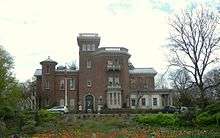Litchfield Villa
Litchfield Villa, or "Grace Hill", is an Italianate mansion built in 1854–1857 on a large private estate now located in Prospect Park, Brooklyn, New York City.[2] It is located on Prospect Park West at 5th Street. The villa was designed by Alexander Jackson Davis, America's leading architect of the fashionable Italianate style for railroad and real estate developer Edwin Clark Litchfield.[3]
Litchfield Villa | |
South side | |
 | |
| Location | Prospect Park W. and 5th St. Brooklyn, New York City |
|---|---|
| Coordinates | 40°40′1″N 73°58′26″W |
| Built | 1854-1857 |
| Architect | A. J. Davis Calvert Vaux |
| Architectural style | Italianate |
| NRHP reference No. | 77000946 |
| NYCL No. | 0153 |
| Significant dates | |
| Added to NRHP | September 14, 1977[1] |
| Designated NYCL | March 15, 1966 |
Description

The structure is considered to be Davis' greatest Italianate villa, and is currently the Brooklyn borough headquarters of the New York City Department of Parks and Recreation. Davis also designed a coach house, greenhouse, and chicken house for the property, none of which is extant. Davis created blueprints in several different styles, including the Gothic Revival and Italianate styles, before eventually selecting the Italianate blueprint.[4]
The villa is located on raised ground behind a short stone retaining wall. The facade is made of brick that is painted to mimic stone. The front of the villa, facing west, contains a square four-story-high tower attached to an octagonal three-story pavilion. The first and third floors of the octagon contain curved bay windows with balconies. On the first floor, there are porches on the north and south sides of the villa, covered by canopies that are supported by columns of the classical order. A pair of cylindrical turrets adorn the north side of the building.[4]
On the first floor inside the octagon, there is a rotunda that is lit by a skylight. A double staircase branches off the south end of the rotunda, rising to the second-floor, and an elaborately decorated drawing room on the first floor is located past the staircase. Past the rotunda and the drawing room. there is a reception room that is also shaped like an octagon, and behind that is a dining room. The first floor also contains a circular library, a map room inside the western turret, and chambers for Edwin Clark Litchfield's wife Grace Hill Hubbard, who was reportedly partially disabled.[4]
The second floor has balconies around the rotunda. A chamber above the first floor dining room contains a skylight and a ticket room. There are also servants' quarters on the villa's north end.[4] On the third floor, there are a chapel and a billiard room, and on the fourth floor, there is a roof terrace.[4]
There was a kitchen and storage rooms in the basement.[4]
History
Litchfield purchased the land in 1852, and the structure was built in 1854–1857 at a cost of $150,000. It predates the construction of Prospect Park, which opened in 1867. The original plans for the park called for it to be built around Litchfield Villa, since Litchfield was loath to sell his property.[4] The New York City Parks Commission ultimately acquired the Litchfield plot in 1868 for $1.7 million, representing 42% of the overall land expenditure for the park, even though the plot constituted just over five percent of the park's acreage.[5]
The Litchfields leased the property from the city until 1882, and the following year, the Brooklyn Park Commission started using the house as its headquarters. Subsequently, Frank J. Helmle designed an annex at the back in 1911–1913.[4]
The villa was listed on the National Register of Historic Places in 1977.[1][6]
After years of neglect, an extensive renovation was funded by an anonymous descendant of the Litchfield family. The renovation, under the direction of architect Ralph Carmosino, was completed in 2008. The original stucco was removed from the house, and many of the interior details, including the elaborately painted ceiling murals, were lost.[7]
See also
- List of New York City Landmarks
- National Register of Historic Places listings in Kings County, New York
References
- "National Register Information System". National Register of Historic Places. National Park Service. April 15, 2008.
- Gray, Christopher (1989-03-12). "STREETSCAPES: The Litchfield Villa; Back to the Past for a Landmark in Prospect Park". The New York Times. ISSN 0362-4331. Retrieved 2019-01-31.
- Peck, Amelia (1992) Alexander Jackson Davis, American Architect, 1803-1892 p.94
- Lancaster, Clay (1972). Prospect Park Handbook (2nd ed.). New York: Long Island University Press. ISBN 0-913252-06-9.
- Morrone, Francis (2001). An Architectural Guidebook to Brooklyn. Salt Lake City: Gibbs-Smith. ISBN 1-58685-047-4.
- Lawrence E. Gobrecht (December 2, 1976). "National Register of Historic Places Registration: Litchfield Villa". New York State Office of Parks, Recreation and Historic Preservation. Retrieved 2008-08-16. (includes one map) See also: "Accompanying five photos, exterior and interior, from 1976". and "Accompanying nomination correspondence".
- Morrone, Francis (May 19, 2008). "New Life for Litchfield Villa in Prospect Park". The New York Sun. Archived from the original on June 7, 2008. Retrieved January 31, 2019.

